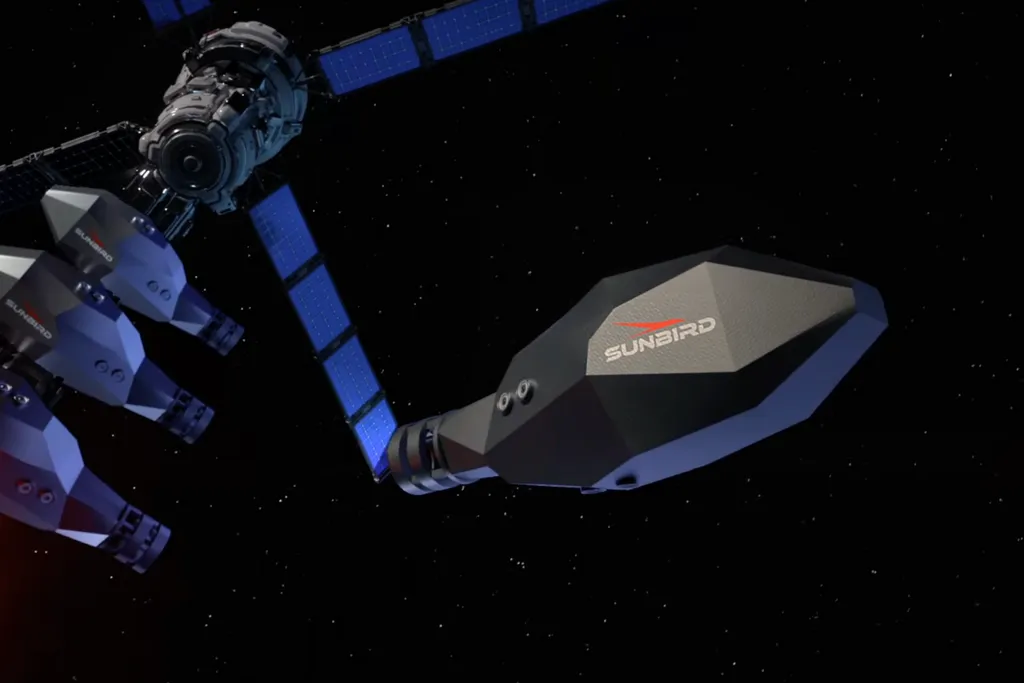Fusion Rockets Could Theoretically Cut Our Travel Time to Mars in Half. This U.K. Startup Wants to Give It a Try
Fusion Rockets Could Theoretically Cut Our Travel Time to Mars in Half. This U.K. Startup Wants to Give It a Try
The company’s ambitious new Sunbird design aims to harness nuclear fusion in space, despite the fact that commercializing such energy on Earth remains a faraway dream
A rendering of a Sunbird rocket detaching from its station to dock onto an approaching spacecraft.
Pulsar Fusion via YouTube
A U.K. startup called Pulsar Fusion has recently unveiled a project it has been developing “in complete secrecy” for the past decade: nuclear fusion-powered rockets called Sunbirds. The company teased the project in a short video of the concept design, which they publicly unveiled at the Space-Comm Expo in London on March 11.
“The Sunbird Migratory Transfer Vehicle is designed to cut mission times to Mars by half while offering a reusable, station-keeping capability for deep space operations,” reads a statement from Pulsar. The company hopes to partner with other missions to rapidly deliver cargo to Mars, supplies to lunar orbit, mining equipment to near-Earth asteroids, probes to outer planets and telescopes to deep space.
Pulsar Fusion’s vision is for its Sunbirds to be permanently stationed in low-Earth orbit, where they would attach to spacecraft leaving our atmosphere and propel them at unprecedented speeds toward far-off destinations, such as Mars or even Pluto. This could dramatically lessen the timeline and cost of missions across our solar system. At the destination, the nuclear spacecraft would recharge and refuel at another Sunbird station, making them reusable for the return journey.
In other words, the Sunbirds would function like space tugboats. Designed to travel at up to 329,000 miles per hour, they would be humanity’s fastest self-propelled objects ever made, as reported by Space.com’s Jeff Spry. NASA’s Parker Solar Probe has traveled faster, but that’s only because it got a boost from the sun’s gravity. Pulsar’s models suggest their design could propel a spacecraft with a mass of around 2,200 pounds to Pluto in four years. (The New Horizons probe from NASA took almost a decade to get to Pluto.)
MIT astronautics researcher Paulo Lozano is “skeptical” of the fusion design, as he tells Live Science’s Harry Baker. Fusion “has been tricky for many reasons and for a long time, especially in compact devices.” Still, he adds that he has “no technical basis to judge,” until the entire Sunbird designs are made public.
Pulsar Fusion Sunbird - Migratory Transfer Vehicle
Watch on
On Earth, all nuclear power plants operate through nuclear fission: splitting atoms to generate an enormous amount of energy. The fission that takes place in most of these power plants consists of smashing a neutron into a uranium atom. When the uranium atom splits, it releases heat and radiation, as well as more neutrons, which smash into other uranium atoms and continue the reaction.
On the other hand, nuclear fusion combines two light atomic nuclei—the cores of atoms, consisting of protons and neutrons—into one heavier atomic nucleus. This process also expels neutrons and energy, but the energy generated by nuclear fusion is much more powerful than fission—and it’s what fuels stars in our universe. In fact, researchers have theorized that fusion could generate nearly limitless amounts of safe and clean energy on Earth, but the scientific advancements that could make this possible on a large scale are still decades away.
“It’s very unnatural to do fusion on Earth,” says Richard Dinan, founder and CEO of Pulsar, to CNN’s Jacopo Prisco. “Fusion doesn’t want to work in an atmosphere. Space is a far more logical, sensible place to do fusion, because that’s where it wants to happen anyway.”
The fusion reaction that would take place in Sunbirds is different from that currently being studied for energy generation on Earth, according to Live Science. On Earth, scientists are aiming to fuse deuterium and tritium—both isotopes, or versions, of hydrogen. The Sunbird engines, however, would replace tritium with helium-3, a rare helium isotope. The reaction between deuterium and helium-3 would expel protons, and their positive charge would be harnessed for propulsion, as well as power to run a spacecraft’s systems.
Aaron Knoll, a researcher in spacecraft engineering at Imperial College London who is not affiliated with Pulsar Fusion, tells CNN that “while we are still some years away from making fusion energy a viable technology for power generation on Earth, we don’t need to wait to start using this power source for spacecraft propulsion.”
Pulsar Fusion’s design is in the third phase of its development, with the ambitious aim of testing Sunbird technology in-orbit in 2027. But exactly when the spacecraft design will become fully operational, if it reaches that stage, remains to be seen.
Get the latest stories in your inbox every weekday.


